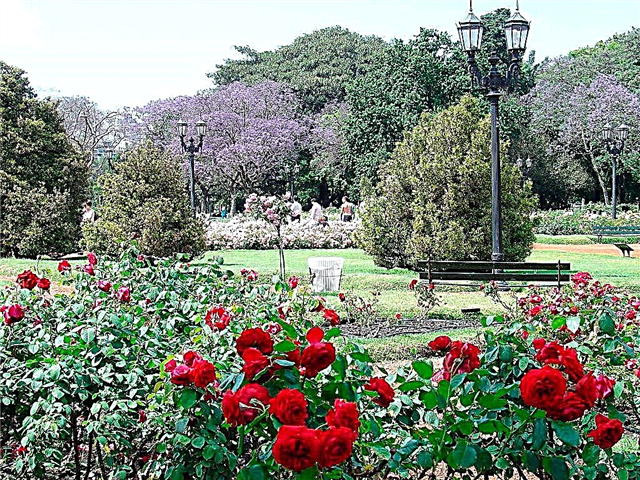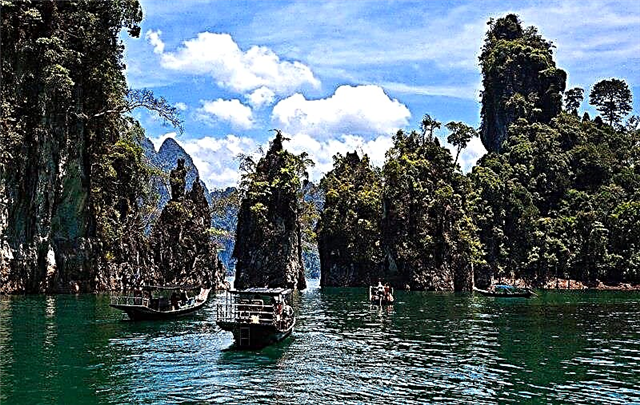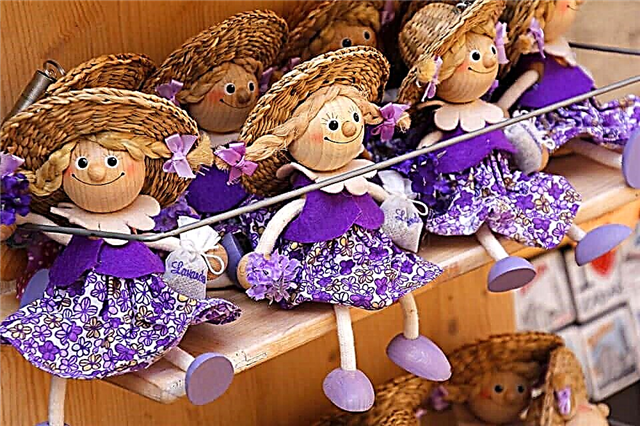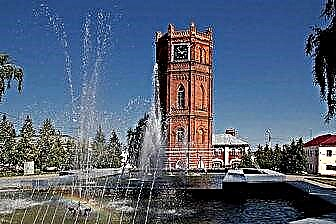Yelets is considered one of the classic merchant cities in Russia. Its beauties are buildings of previous eras, carefully preserved or restored. They have undergone a number of changes, but they were able to convey to new generations an idea of the orders and traditions of the past. The fire tower adorns the existing fire station, and the former water tower has turned into a local chime.
There are many Orthodox churches within the city, each with its own history. The names of people important to the city are immortalized in the museum houses founded and named after them. The Bunin Museum became the first in the country dedicated to the writer, and the Khrennikov Museum is currently the only one of its kind.

The best hotels and hotels at affordable prices.
from 500 rubles / day
What to see and where to go in Yelets?
The most interesting and beautiful places for walking. Photos and a short description.
Ascension Cathedral
It was built in the second half of the 19th century in the central part of the city. The authorship of the project belongs to the famous architect Konstantin Ton. In 1934, the temple was destroyed by burning icons right in the building. Unlike most religious institutions in the country, the cathedral was returned to its status already in 1947. The iconostasis is three-tiered, made of gilded carved wood. Due to its impressive size, the temple is visible from many parts of Yelets.

City clock tower
Located at the intersection of Sverdlova and Sovetskaya streets. The tower was erected in 1868 and was used as a water tower. The chimes were installed on it in the 70s of the last century. The clock makes itself felt every 15 minutes. In the immediate vicinity of this attraction there are: a monument to the artist Zhukov, the Grand Ducal Church, the city park and the Karakumovsky pedestrian bridge.

Fire Tower
Built on the initiative of the Valuisky brothers in 1865. The merchants recruited their own fire brigade from the workers of the factory they owned. They themselves participated in extinguishing urban fires. The case of Nikolai and Dmitry was continued by their descendants. Among other things, they replaced the wooden watchtower with a brick one. There is an observation deck on it, and a modern fire station works in the building.

Mira street
It is a walking area of the city. It is interesting for its buildings - many of the buildings here are original and erected in different years. In the past it was a shopping street, although today there are many shops on it. At the same time, the signs do not always coincide with the contents of the shops. Blotches of old paving stones are visible. Forged decorative details such as lanterns can be seen on the buildings. There are benches and green spaces.

Grand Ducal Church
The end of construction in 1911 was timed to coincide with the 300th anniversary of the Romanovs' reign. The architect Wilfart was responsible for the project. This name was chosen because the church is dedicated to the princes of Tverskoy and Nevsky. The facade of the building is distinguished by a bright color scheme, numerous details and decorations. The interiors are also richly furnished: carved furniture, ceramic iconostasis, colored stained-glass windows.

Church of the Transfiguration
It was built in 1771, replacing the old wooden building. After 40 years, the limits were lengthened, and the refectory was expanded. In 1871, a bell tower was added to the church. In its current form, the temple, which has gone through restoration, is single-domed. In the course of the work, some details like the porticoes were lost, but decorative elements appeared in the design of the facade. The bell tower has survived, but its style has become more Baroque.

Znamensky Convent
Founded in 1683. Although the monastery lost its status in 1764, the nuns did not leave it. After 5 years, the monastery burned down. The monastery turned into a hermit, the number of sisters increased. It was restored by the decree of Alexander I. The second closure happened after the revolution. The buildings fell into disrepair, so the revival in the 2000s was not easy. Among other things, the Znamensky Cathedral was rebuilt.

Drama theater "Benefis"
Formed in 1993. Then he occupied the building of the People's House. The creator of the collective was the director Nazarov. He previously worked at the Almaty theater of the same name. His work was continued by his associates and followers. The repertoire of the troupe is diverse, some of the performances have been highly appreciated by authoritative publications and theater awards. At the moment, Benefis is headed by Radion Bukaev, one of Yevgeny Mironov's students.

Yeletsk city museum of local lore
Although it was founded in 1901, its history consists of constant destruction in the early years of its existence. He suffered both from the revolutionaries and from their opponents. The collection had to be rebuilt many times. Including after the Second World War. It has existed in its current form since 1971 without any major upheavals. The funds contain typical local history materials about Yelets and its surroundings.

House-Museum of Yelets Lace
The landmark building is blue. All knowledgeable people associate it with local lace. Currently, the house-museum belongs to a company that produces all kinds of products using lace-making techniques. Tourists are shown the process of making various things and are told about the history of the craft. Here you can also see ready-made tablecloths, dresses, napkins.

Museum of Folk Crafts and Crafts
It has existed since 2007. The purpose of its creation is to revive interest in local folk crafts. Among the exhibits are examples of beading, blacksmithing, wood carving, and weaving. Garments, furniture, toys and many practical items are all crafted using the most amazing techniques. The halls of the museum are spacious, guides provide historical information about any of the directions.

House-Museum of T. N. Khrennikov
The opening ceremony in 2000 was attended by the composer himself. This is the only museum in his honor in Russia. Some halls recreate the interiors of the house, in others personal belongings are presented, in others - both. Music written by Tikhon Nikolaevich is constantly played in the house. A monument to Khrennikov is erected in the courtyard: a bust on a pedestal, and in the background a piano lid with the years of the musician's life.

I. A. Bunin Literary Memorial Museum
It has been receiving visitors since 1988. It is the first museum dedicated to Bunin. He lived in this house during his studies at the gymnasium. The building is one-story, the exposition is divided into seven rooms. Furniture of that era is collected inside to reliably recreate the atmosphere surrounding the writer. There are personal belongings, books, memorabilia. During the tour, the guides tell a lot of stories about Yelets and Bunin.

Monument to I. Bunin
Located at the Victory Fountain. Installed in honor of the 125th anniversary of the birth of the writer. Bunin is depicted relaxingly sitting on an armchair and looking at the city. The name of the writer is engraved on the pedestal. Materials - bronze and granite. The authors of the project are the artist Grishko and the architect - Achkasova. This is not the only monument to Bunin in Yelets, but the most beloved by both locals and tourists.

House-Museum of N. Zhukov
Began to receive visitors in 1992. Moving from room to room, you can learn about the biography and creative path of the artist. During his lifetime he said that he would like to see his museum in Yelets, where he spent his childhood and youth. The collection was replenished with personal belongings of Zhukov, transferred by his relatives, as well as original works. The exposition is constantly changing to make it interesting for visitors to come back here.

Monument to the artist Zhukov
Opened in 2008. The composition includes an artist sitting on a bench, a girl he is painting, and a boy looking with interest at the master's canvas.The monument looks especially beautiful in late spring and summer: there is a lot of greenery around, flower beds are blooming. Although at other times of the year the composition is lively and curious. A popular location for photo shoots with locals and visitors alike.

Memorable sign in honor of the 850th anniversary of Yelets
Installed on Red Square in 1996. Dedicated to the 850th anniversary of the founding of the city. The architect Shashin was responsible for creating the project. The place was not chosen by chance: in the past, there was a destroyed cathedral here. The composition combines representatives of different eras, one way or another connected with the city. In 2010, the monument to the mute was updated, and a dome with a cross was added.

Karakum bridge
Thrown across the river called Swift Pine. Traffic on it has been allowed since 1933. The length is 198 meters. It was destroyed and rebuilt more than once. At the turn of the 70s and 80s, it lost its former status due to the construction of a "competitor". Then it became a pedestrian, but in the 90s it was completely closed due to an emergency condition. The major reconstruction was completed in 2005, but the bridge was still pedestrianized.

Vorgol rocks
They can be easily found near the village of Nizhniy Vorgol. The places are picturesque, it is convenient to get there. A river flows nearby, on the coast in the warm season there are many campers with tents. There are several sites with rocks. They are quite tall and suitable for climbing. There are elevations with bizarre "outgrowths" that seem to hang over the lowlands. They are part of the natural reserve "Vorgolskie Rocks".

Taldykin's estate
The estate stands on the bank of the river near the water. Under her there was a water mill, which was burned during the retreat during the Second World War. At the same time, the brick frame itself has survived to this day. This is due to the special strength of the walls, which are about a meter thick. Under Soviet rule, the estate was a recreation center, now it is private property. The natural reserve "Vorgolskie Rocks" is located nearby.












